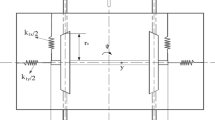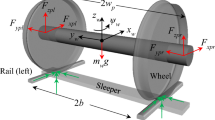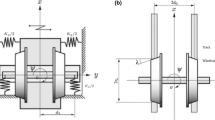Abstract
Railway vehicle hunting instability frequently occurs due to severe operating conditions, significantly affecting trains’ running quality. This paper examines the hunting motion and bifurcation characteristics of a railway wagon fitted with three-piece bogies, emphasizing the effect of wheel profile wear. The Poincaré sections describe the wagon system’s hunting motion characteristics and bifurcation evolutionary trends, which are defined according to the dynamical system’s geometric phase space structure. The influence of the wheel wear on the nonlinear stability of the wagon system is conducted, and the effects of friction performance are investigated subsequently, in which fundamental features of hunting and bifurcations are revealed in detail. The results indicate that the solution branches generate a conspicuous evolution due to the development of wheel wear, which is a process of first simplicity and then complexity. In addition, the frictional characteristics of the system (wheel-rail and wedge friction) are crucial to the system bifurcation. The combination of different friction performance and worn wheel profiles can lead to entirely different system bifurcation. The bifurcation characteristics of the wagon system are demonstrated and analyzed in detail, the different motion regions are divided according to the corresponding characteristics, and the evolution process of the nonlinear dynamic response of the system during the development of wheel wear is further proposed.















Similar content being viewed by others
Data availability
Enquiries about data availability should be directed to the authors.
References
Persson, R., Andersson, E., Stichel, S., Orvnäs, A.: Bogies towards higher speed on existing tracks. Int. J. Rail Transp. 2, 40–49 (2014). https://doi.org/10.1080/23248378.2013.878294
Papangelo, A., Putignano, C., Hoffmann, N.: Self-excited vibrations due to viscoelastic interactions. Mech. Syst. Signal Process. (2020). https://doi.org/10.1016/j.ymssp.2020.106894
Saunders, B.E., Vasconcellos, R., Kuether, R.J., Abdelkefi, A.: Characterization and interaction of geometric and contact/impact nonlinearities in dynamical systems. Mech. Syst. Signal Process. (2022). https://doi.org/10.1016/j.ymssp.2021.108481
Zhang, J., Zhu, T., Yang, B., Wang, X., Xiao, S., Yang, G., Liu, Y., Che, Q.: A rigid–flexible coupling finite element model of coupler for analyzing train instability behavior during collision. Railway Eng. Sci. 31, 325–339 (2023). https://doi.org/10.1007/s40534-023-00308-2
Yang, T., Zhou, S., Litak, G., Jing, X.: Recent advances in correlation and integration between vibration control, energy harvesting and monitoring. Nonlinear Dyn. 111, 20525–20562 (2023). https://doi.org/10.1007/s11071-023-08999-2
Zhou, S., Hou, B., Zheng, L., Xu, P., Yu, T., Ren, Z.: Nonlinear property and dynamic stability analysis of a novel bio-inspired vibration isolation–absorption structure. Nonlinear Dyn. 112, 887–902 (2024). https://doi.org/10.1007/s11071-023-09084-4
Bustos, A., Tomas-Rodriguez, M., Rubio, H., Castejon, C.: On the nonlinear hunting stability of a high-speed train bogie. Nonlinear Dyn. 111, 2059–2078 (2023). https://doi.org/10.1007/s11071-022-07937-y
Yan, Y., Zeng, J.: Hopf bifurcation analysis of railway bogie. Nonlinear Dyn. 92, 107–117 (2018). https://doi.org/10.1007/s11071-017-3634-7
Zhang, T.T., True, H., Dai, H.: The influence of the perturbation of the wheel rotation speed on the stability of a railway bogie on steady curve sections of a track. Veh. Syst. Dyn. 57, 425–443 (2019). https://doi.org/10.1080/00423114.2018.1469778
Yao, Y., Li, G., Wu, G., Zhang, Z., Tang, J.: Suspension parameters optimum of high-speed train bogie for hunting stability robustness. Int. J. Rail Transp. 8, 195–214 (2020). https://doi.org/10.1080/23248378.2019.1625824
Zeng, X.H., Lai, J., Wu, H.: Hunting stability of high-speed railway vehicles under steady aerodynamic loads. Int. J. Struct. Stab. Dyn. (2018). https://doi.org/10.1142/s0219455418500931
Wang, J.C., Ling, L., Ding, X., Wang, K.Y., Zhai, W.M.: The influence of aerodynamic loads on carbody low-frequency hunting of high-speed trains. Int. J. Struct. Stab. Dyn. (2022). https://doi.org/10.1142/s0219455422501450
Jiang, C.C., Zhang, H., Ling, L., Liu, T., Gao, J.M., Wang, K.Y., Zhai, W.M.: Modelling and simulation of nonlinear dynamic characteristics of yaw dampers subjected to variable temperature operation condition of high-speed trains. Nonlinear Dyn. (2023). https://doi.org/10.1007/s11071-023-08831
Li, Y., Chi, M., Guo, Z., Liang, S.: An abnormal carbody swaying of intercity EMU train caused by low wheel–rail equivalent conicity and damping force unloading of yaw damper. Railway Eng. Sci. 31, 252–268 (2023). https://doi.org/10.1007/s40534-022-00295-w
Ling, L., Dhanasekar, M., Thambiratnam, D.P., Sun, Y.Q.: Minimising lateral impact derailment potential at level crossings through guard rails. Int. J. Mech. Sci. 113, 49–60 (2016). https://doi.org/10.1016/j.ijmecsci.2016.04.011
Ling, L., Dhanasekar, M., Thambiratnam, D.P., Sun, Y.Q.: Lateral impact derailment mechanisms, simulation and analysis. Int. J. Impact Eng 94, 36–49 (2016). https://doi.org/10.1016/j.ijimpeng.2016.04.001
Ling, L., Dhanasekar, M., Thambiratnam, D.P.: Frontal collision of trains onto obliquely stuck road trucks at level crossings: derailment mechanisms and simulation. Int. J. Impact Eng 100, 154–165 (2017). https://doi.org/10.1016/j.ijimpeng.2016.11.002
Cooperrider, N.K.: The hunting behavior of conventional railway trucks. J. Eng. Ind. 94, 752–761 (1972). https://doi.org/10.1115/1.3428240
Ahmadian, M., Yang, S.P.: Hopf bifurcation and hunting behavior in a rail wheelset with flange contact. Nonlinear Dyn. 15, 15–30 (1998). https://doi.org/10.1023/A:1008278713331
Ahmadian, M., Yang, S.P.: Effect of system nonlinearities on locomotive bogie hunting stability. Veh. Syst. Dyn. 29, 365–384 (1998). https://doi.org/10.1080/00423119808969380
True, H.: On the theory of nonlinear dynamics and its applications in vehicle systems dynamics. Veh. Syst. Dyn. 31, 393–421 (1999). https://doi.org/10.1076/vesd.31.5.393.8361
True, H., Asmund, R.: The dynamics of a railway freight wagon wheelset with dry friction damping. Veh. Syst. Dyn. 38, 149–163 (2002). https://doi.org/10.1076/vesd.38.2.149.5617
Stichel, S.: Limit cycle behaviour and chaotic motions of two-axle freight wagons with friction damping. Multibody Syst. Dyn. 8, 243–255 (2002). https://doi.org/10.1023/a:1020990128895
Hoffmann, M.: On the dynamics of European two-axle railway freight wagons. Nonlinear Dyn. 52, 301–311 (2008). https://doi.org/10.1007/s11071-007-9279-1
Schupp, G.: Bifurcation analysis of railway vehicles. Multibody Sys. Dyn. 15, 25–50 (2006). https://doi.org/10.1007/s11044-006-2360-6
Zhai, W.M., Wang, K.Y.: Lateral hunting stability of railway vehicles running on elastic track structures. J. Comput. Nonlinear Dyn. (2010). https://doi.org/10.1115/1.4001908
True, H.: Multiple attractors and critical parameters and how to find them numerically: the right, the wrong and the gambling way. Veh. Syst. Dyn. 51, 443–459 (2013). https://doi.org/10.1080/00423114.2012.738919
Cole, C., Spiryagin, M., Sun, Y.Q.: Assessing wagon stability in complex train systems. Int. J. Rail Transp. 1, 193–217 (2013). https://doi.org/10.1080/23248378.2013.836396
Polach, O., Kaiser, I.: Comparison of methods analyzing bifurcation and hunting of complex rail vehicle models. J. Comput. Nonlinear Dyn. (2012). https://doi.org/10.1115/1.4006825
Polach, O., Nicklisch, D.: Wheel/rail contact geometry parameters in regard to vehicle behaviour and their alteration with wear. Wear 366–367, 200–208 (2016). https://doi.org/10.1016/j.wear.2016.03.029
Zboinski, K., Dusza, M.: Bifurcation analysis of 4-axle rail vehicle models in a curved track. Nonlinear Dyn. 89, 863–885 (2017). https://doi.org/10.1007/s11071-017-3489-y
Zboinski, K., Golofit-Stawinska, M.: Investigation into nonlinear phenomena for various railway vehicles in transition curves at velocities close to critical one. Nonlinear Dyn. 98, 1555–1601 (2019). https://doi.org/10.1007/s11071-019-05041-2
Zhai, W.M.: Vehicle–Track Coupled Dynamics Theory and Applications. Springer, Singapore (2020)
Ling, L., Jiang, P.B., Wang, K.Y., Zhai, W.M.: Nonlinear stability of rail vehicles traveling on vibration-attenuating slab tracks. J. Comput. Nonlinear Dyn. (2020). https://doi.org/10.1115/1.4047087
Kalker, J.J.: A fast algorithm for the simplified theory of rolling contact. Veh. Syst. Dyn. 11, 1–13 (1982). https://doi.org/10.1080/00423118208968684
Cole, C., McClanachan, M., Spiryagin, M., Quan Sun, Y.: Wagon instability in long trains. Veh. Syst. Dyn. 50, 303–317 (2012). https://doi.org/10.1080/00423114.2012.659742
Xia, F.J., True, H.: On the dynamics of the three-piece-freight truck. In: Proceedings of the 2003 IEEE/ASME Joint Railroad Conference, pp. 149–159 (2003). https://doi.org/10.1109/RRCON.2003.1204661
Xia, F.J., Cole, C., Wolfs, P.: The effects of the friction between frame and adapters on the performance of three-piece truck. In: Proceedings of the 2006 IEEE/ASME Joint Rail Conference, pp. 161–168. https://doi.org/10.1109/RRCON.2006.215306
Xia, F.J., Cole, C., Wolfs, P.: An inverse railway wagon model and its applications. Veh. Syst. Dyn. 45, 583–605 (2007). https://doi.org/10.1080/00423110601079151
Xia, F.J., Cole, C., Wolfs, P.: Grey box-based inverse wagon model to predict wheel–rail contact forces from measured wagon body responses. Veh. Syst. Dyn. 46, 469–479 (2008). https://doi.org/10.1080/00423110801993102
Yang, Y., Ling, L., Wang, J., Zhai, W.: A numerical study on tread wear and fatigue damage of railway wheels subjected to anti-slip control. Friction 11, 1470–1492 (2023). https://doi.org/10.1007/s40544-022-0684-8
Ye, Y., Vuitton, J., Sun, Y., Hecht, M.: Railway wheel profile fine-tuning system for profile recommendation. Railway Eng. Sci. 29, 74–93 (2021). https://doi.org/10.1007/s40534-021-00234-1
Wang, X.C., Lu, Z.G., Wen, J.C., Wei, J.Y., Wang, Z.H.: Kinematics modelling and numerical investigation on the hunting oscillation of wheel-rail nonlinear geometric contact system. Nonlinear Dyn. 107, 2075–2097 (2022). https://doi.org/10.1007/s11071-021-07103-w
Ge, P.H., Wei, X.K., Liu, J.Z., Cao, H.J.: Bifurcation of a modified railway wheelset model with nonlinear equivalent conicity and wheel-rail force. Nonlinear Dyn. 102, 79–100 (2020). https://doi.org/10.1007/s11071-020-05588-5
Qu, S., Wang, J.B., Zhang, D.F., Li, D.D., Wei, L.: Failure analysis on bogie frame with fatigue cracks caused by hunting instability. Eng. Fail. Anal. (2021). https://doi.org/10.1016/j.engfailanal.2021.105584
Li, W., Guan, Q.H., Chi, M.R., Wen, Z.F., Sun, J.F.: An investigation into the influence of wheel-rail contact relationships on the carbody hunting stability of an electric locomotive. Proc. Inst. Mech. Eng. Part F-J. f Rail Rapid Transit 236, 1198–1209 (2022). https://doi.org/10.1177/09544097221084412
Gao, X.J., Li, Y.H., Yue, Y.: The “resultant bifurcation diagram” method and its application to bifurcation behaviors of a symmetric railway bogie system. Nonlinear Dyn. 70, 363–380 (2012). https://doi.org/10.1007/s11071-012-0460-9
Gao, X.J., Li, Y.H., Yue, Y., True, H.: Symmetric/asymmetric bifurcation behaviours of a bogie system. J. Sound Vib. 332, 936–951 (2013). https://doi.org/10.1016/j.jsv.2012.09.011
Guo, J.Y., Shi, H.L., Luo, R., Zeng, J.: Bifurcation analysis of a railway wheelset with nonlinear wheel-rail contact. Nonlinear Dyn. 104, 989–1005 (2021). https://doi.org/10.1007/s11071-021-06373-8
Hazrati Ashtiani, I., Rakheja, S., Ahmed, A.K.W.: Influence of friction wedge characteristics on lateral response and hunting of freight wagons with three-piece bogies. Proc. Inst. Mech. Eng. Part F-J. Rail Rapid Transit 231, 877–891 (2017). https://doi.org/10.1177/0954409716647095
Hazrati Ashtiani, I.: Optimization of secondary suspension of three-piece bogie with bevelled friction wedge geometry. Int. J. Rail Transp. 5, 213–228 (2017). https://doi.org/10.1080/23248378.2017.1336652
Zhang, T.T.: Research on the Nonlinear Stability and Hopf Bifurcation Transformation Mechanism of High-speed Railway Vehicles [Dissertation]. Southwest Jiaotong University, Chengdu (2019). (in Chinese)
Funding
The author(s) disclosed receipt of the following financial support for the research, authorship, and/or publication of this article: the National Natural Science Foundation of China [Grant Number U2268210, 52072317, 52388102].
Author information
Authors and Affiliations
Contributions
JC.W contributed to the writing of the original draft, simulation, data analysis, and visualization. L.L, KY.W and WM.Z contributed to conceptualization, writing guidance, and supervision. JC.W and L.L performed the investigation and data curation. All authors contributed to writing, reviewing, and editing the manuscript.
Corresponding author
Ethics declarations
Conflict of interest
The authors declare that they have no known competing financial interests or personal relationships that could have appeared to influence the work reported in this paper.
Additional information
Publisher's Note
Springer Nature remains neutral with regard to jurisdictional claims in published maps and institutional affiliations.
Rights and permissions
Springer Nature or its licensor (e.g. a society or other partner) holds exclusive rights to this article under a publishing agreement with the author(s) or other rightsholder(s); author self-archiving of the accepted manuscript version of this article is solely governed by the terms of such publishing agreement and applicable law.
About this article
Cite this article
Wang, J., Ling, L., Wang, K. et al. Nonlinear stability evolution of railway wagon system due to wheel profile wear. Nonlinear Dyn (2024). https://doi.org/10.1007/s11071-024-09665-x
Received:
Accepted:
Published:
DOI: https://doi.org/10.1007/s11071-024-09665-x




